The Spin Cycle differs from the Genesis Cycle in that it actually has a story arc. Sure, there were short vignettes for each of the runners in the Genesis Cycle, but each was standalone. Above is the insert from the first pack in the Spin Cycle, Opening Moves. It consists of two press releases: one from Weyland about a murder committed by a bioroid at one of their facilities, and one from Haas-Bioroid denouncing the murder as an act of terror. Why was the bioroid reprogrammed to kill a researcher associated with Weyland Consortium? We will find out more as the cycle unfolds, but for now, let us take a look at the cards from this pack.
Frame Job
This is the first of a new subtype for both events and operations: double. Essentially, a double event requires you to spend a click as an additional cost to play, meaning you will need at least 2 clicks to play one. Generally, double events have powerful effects for such a cost. In this case, you forfeit an agenda to give the corporation 1 bad publicity. That may seem like a setback. After all, you need to steal agendas to win. But, if you can give up an agenda that is only worth 1 or even 0 points, you now have 1 free credit for every run you make afterwards. Also, there are some corporation cards that can be added to your score pile as agendas worth negative points, so this could be a way to benefit from those. Still, you will have to decide if it is worth giving up those precious agendas to utilize this card.
Trivia: Because bad publicity functioned differently in the Netrunner CCG, there is not exactly a direct correlation between this card and any from that game. However, there were a series of runner cards for giving the corporation bad publicity in the Proteus expansion, and one of them was named Frame-Up. Granted, that card required you to make a successful run on HQ and R&D, and then you give the corporation 1 bad publicity, plus 1 bad publicity for each Black Ops card you stole or trashed during the turn.
Pair cards: Notoriety, Fan Site
Pawn
The first of a new set of Anarch programs, Pawn is small and unassuming. You can spend a click to host it on the outermost piece of ice protecting one of the central servers. Of course, if the corporation decided not to bother icing their centrals, you will be unable to do this. But assuming they did defend those centrals, every time you make a successful run, you move Pawn to the piece of ice directly after the piece of ice it is on. If it is on the innermost piece of ice, then instead you trash Pawn and install a Caïssa program from your hand or discard pile, ignoring all costs. While this may seem like a complex way to get another program for free, it actually formed the backbone of the Street Chess deck, which used this card along with Exile's ability and Scheherazade to gain credits and cards every time you ran.
Trivia: Caïssa is a fictional Thracian dryad portrayed as a goddess of chess.
Pair cards: Caïssa programs, Deep Red, Scheherazade
Rook
Again, this does not seem like much. For 2 credits, you can increase the rez cost of each piece of ice on a server by 2. But if you think about it, that could significantly hamper the corporation for a run. If you place this on a server with 3 unrezzed pieces of ice, you have increased the cost for the corporation to defend it by 6, which could be enough to keep them from rezzing everything. But say it is after that, and the corporation has already rezzed their ice. Well, you can move Rook onto another server. However, this card moves exactly like the chess piece it is named for, and can only move to another ice on the server it is already on, or to a piece of ice in the same position as on another server, so it may take you some extra time to place it where you want it. Of course, the corporation may just decide to trash the ice hosting Rook, which could be beneficial to you as well.
Pair cards: Pawn, Deep Red, Nasir Meidan: Cyber Explorer, Social Engineering
Hostage
Okay, this is incredible. For 1 credit and 2 clicks, you can search your deck for a connection resource, reveal it to the corporation, and add it to your hand. But, you can also install that connection by paying its install cost. Sure, if you do not have the money for that install, you have essentially lost the click, but this is still a really great way to get out that connection you absolutely need, such as Kati Jones, or getting another copy of Underworld Contact to boost your economy.
Pair cards: all connections, Calling in Favors, Off-Campus Apartment
Gorman Drip v1
This card does not see that much play. This sort of works as a bank, where each time the corporation spends a click to draw a card or gain a credit, you get a credit. That means it is mostly dependent on the corporation. But, it is possible to work a way to put virus counters onto this solely on your turn. It may be possible to make a large chunk of money off of this, although there are probably more efficient ways to do so.
Pair cards: Déjà Vu, Cyberfeeder, Grimoire, Djinn, Surge, Incubator, Hivemind
Lockpick
Another stealth card, although this one can only be used to pay for using decoders. As such, you will only be getting use out of this if your opponent has code gate ice installed, and if you have your decoder installed. Still, it is a very cheap way to get a recurring credit, and unlike Cloak it does not take up any memory, so you can install these without worrying about having to overwrite anything.
Pair cards: Replicator, Refractor, Mirror, Houdini
False Echo
Not used that much, although there are some possibilities. If you have this installed and pass a piece of unrezzed ice, you can trash this card to force the corporation to either rez that piece of ice or add it to their hand. So, you could possibly force a tough decision onto the corporation. But, if you can hedge your bets, such as using expose effects to reveal what several pieces of ice are, you might be able to force the choice by returning a piece of ice to the corporation's hand. Or you might force the corporation to rez an expensive piece of ice after you have already gotten past it so that they do not have to reinstall it.
Trivia: The Netrunner CCG has a card named False Echo, although that card functions differently. After making a successful run on a fortress, you can pay 2 credits to force the corporation to rez as much ice as possible, starting with the outermost piece of ice and working inward.
Pair cards: Infiltration, Cortez Chip, Satellite Uplink, Social Engineering
Motivation
This card is interesting. It allows you to look at the top card of your deck, which means you can decide whether or not it is worth drawing. But what is more interesting is that there are several cards that require you to take a risk on the top card of your deck. Normally, you would have to build your deck in a specific way to take advantage of those cards. With this card, you can eliminate that risk.
Pair cards: Eureka!, Oracle May
John Masanori
This card benefits you for making a successful run, which is something you already want to do. Add in a few more cards that give benefits on successful runs, and you can have a decent draw engine along with whatever else you are going for. But, you only get to draw a card on the first successful run, so additional runs do not help as much. Also, if you make an unsuccessful run, you have to take a tag, which means spending extra time and money getting rid of that tag. Although, there are ways to take advantage of gaining a tag as well. But if you know you can make a successful run each turn, you can take good advantage of this card.
Pair cards: Datasucker, Desperado, Dirty Laundry, Security Testing, Patron
Project Ares
Something that has potential, but has not seen much play. If you have advanced this card beyond 4 counters, then for each additional counter on it, the runner must trash one of their installed cards. This means that you could potentially destroy the runner's rig. Of course, that means you have to spend time and money over advancing it, as well as protecting it. Plus, if the runner ends up trashing any of their cards, you take 1 bad publicity. As such, most corporations do not see a benefit to running this, as there are other agendas worth 2 points that give more benefit for less investment.
Trivia: Project Ares is named for Ares, the Greek god of war. Project Ares also features pretty heavily in Mel Odom's Identity trilogy (Golem, Mimic, and Rebel,) as the production and deployment of bioroids for combat could turn the tide of the insurrection on Mars. And considering that Mars is the name for the Roman god of war, there is another bit of connection in that.
Pair cards: Trick of Light, Shipment from SanSan
NEXT Bronze
The start of the NEXT series of ice is pretty basic. Each piece of rezzed NEXT ice gives this code gate 1 point of strength. So when it first came out, this card maxed out at 3 strength. But right now, this could potentially have a strength of 10, making it a very formidable code gate for its cost, if you build around it.
Pair cards: NEXT Silver, Mother Goddess, NEXT Gold, NEXT Wave 2
Celebrity Gift
Jinteki has had problems with economy since the core set, and Genesis did not do much to fix that. So enter this card. For 2 clicks and 3 credits, you could gain up to 10 credits, for a potential net gain of 7. The catch is that to get these credits, you have to reveal cards in your hand to the runner, getting 2 credits for each card you show. This is quite the double-edged sword. If you show the runner you have agendas in hand, they know they can go for them. If you show the runner traps and other non-agenda cards, they know they can ignore your HQ. Still, if you can show them a mix of traps and maybe 1 agenda, it could give them a tough decision on whether or not to risk the traps to try for the agenda.
Pair cards: Snare!, Fetal AI, Shock!
Himitsu-Bako
Cheap to rez, this card makes for a decent early game barrier. Of course, once the runner has their fracter installed, this becomes a speed bump, but there is another function. While this card is rezzed, you can spend 1 credit to return it to your hand. So if the runner has any programs installed on this card, all of those programs are trashed. Or suppose the runner is about to access multiple cards from your HQ. You can spend a credit to return this, reducing the probability they will access a card that would be good for them slightly. As such, if you need a cheap barrier in your Jinteki deck, this might work decently for you.
Trivia: Himitsu-Bako is Japanese for "puzzle box."
Pair cards: Mutate, Superior Cyberwalls
Character Assassination
Most runners are rather dependent on their resources. You can punish that by trashing their resources if they are tagged. But what if they have high link strength, or just shake off any tags they take? Well, with this card, you can bypass that requirement and just trash one of their resources for free. As an added bonus, they can not prevent that resource from being trashed, so even if they have piled up copies of Fall Guy, there is nothing they can do about it. Of course, if the runner has no resources installed, then you get nothing from scoring this card, so you have to install it at the right time.
Pair cards: 24/7 News Cycle
Jackson Howard
Ah, Jackson Howard. Free to rez, 3 to trash, and lets you draw 2 cards for 1 click. On its own, this would be worth running in any deck, but it is his other ability that makes him an auto-include in almost every deck. By pulling him out of the game, you can shuffle up to 3 cards from your discard pile back into your deck. This extends the game a bit further by giving the corporation some additional recursion. There are so many ways to take advantage of this. You could shuffle economy cards back into your deck to get more money, or you could put ice the runner destroyed back into your deck. You could take agendas out of your discard pile just before the runner would access them, or you could take any non-agenda cards back into your deck to lower the chance that they will access an agenda on an R&D run. Still, Jackson is no longer infallible, as the existence of Rumor Mill means that at any time, the runner could render him useless. But aside from that, you can get a lot of use out of Jackson in your deck.
Trivia: Jackson has quite the history. His work on an edutainment toy with a micro-optic brain that could take data learned from children in order to create an improved psychographic profile led to CEO Victoria Jenkins promoting him to VP of Child Programming. He is involved in most of the entertainment aimed at children that comes from NBN, but most specifically Sunshine Junction, which I have touched on before. He is also a minor character in the Leigh Alexander novella Monitor.
Oh, and the card is sort of a reprint. ESA Contract from the Netrunner CCG has the exact same rez cost, trash cost, and has the ability to draw 2 cards for 1 action. But it does not have the recursion ability.
Pair cards: Executive Boot Camp, Tech Startup, Executive Search Firm
Invasion of Privacy
It is pretty hard to justify this card. It is a double operation, so you will be investing 2 clicks into playing this card. Then, you start a trace with a base strength of 2, meaning that you will have to invest a good amount of credits into it to succeed if the runner has a stockpile of credits or a high link strength. But if you can pull it off, you reveal the runner's hand and can trash a number of resources and/or events from their hand equal to the amount by which your trace strength exceeded their link strength. So this could potentially discard a lot of cards from their hand. But if they have no resources or events in hand, you have spent a lot of money just to see what they are holding onto. Even worse, if you fail the trace, you take a point of bad publicity. As such, this card is a major gamble. You could possibly do a lot of damage to the runner, or do nothing, or end up benefiting the runner. Still, this is one of the few ways to do damage to the runner without tagging them, and losing their resources and events out of hand could set them back a few turns, so you may be able to get use out of this card.
Pair cards: NBN: Making News, Primary Transmission Dish, Targeted Marketing, Aryabhata Tech
Geothermal Fracking
Combining the effects of 2 copies of Hostile Takeover into 1 card, we have this. It takes 4 advancement tokens and is worth 2 points, but scoring it could be quite a boost to your economy. When you score it, you place 2 agenda counters onto it. Then, you can spend a click and a counter to gain 7 credits and a bad publicity. As such, this is potentially worth 10 credits above its advancement cost, but taking those bad publicity tokens does help the runner. If you can remove the bad publicity, or have some way to mitigate it, then this card can become very profitable.
Trivia: "Fracking," or "hydraulic fracturing," is the process of injecting a mixture of water and chemicals into a wellbore so that natural gas, petroluem and brine flow more easily. In this case, it would seem that the mixture is being injected into a geothermal vent, producing steam, which can be used to generate electricity.
Pair cards: Witness Tampering, Titan Transnational: Investing In Your Future, 24/7 News Cycle
Swarm
The first piece of illicit ice, Swarm has some potential. Because it is illicit, rezzing it forces you to take 1 bad publicity. Plus, this card has to be advanced before it gains any subroutines, so you have to spend some time and money into advancing it. But each advancement token on it gives it a subroutine that reads "Trash 1 program unless the runner pays 3 credits." So each advancement token on it forces the runner to spend 3 credits or let you trash a program, unless they can afford to break this. With 5 strength, that could possibly be more expensive at a few counters. Of course, if the runner has no programs, this card does nothing, so if they sacrifice their programs, they can just get through this. As such, you want this outside of your ice that can end the run.
Pair cards: Shipment from Kaguya, Shipment from SanSan, Builder, Satellite Grid, Dedication Ceremony
Cyberdex Trial
The main benefit of this card is the ability to purge virus counters for 1 click instead of 3 clicks. That gives you 2 additional clicks on your turn. Of course, if the runner has no viruses, then this card is useless to you. So your choice on whether or not to use this will depend on what runner decks the people in your area are playing, or if your deck is particularly vulnerable to certain viruses, such as Clot or Medium.
Pair cards: Accelerated Diagnostics
Grim
Another piece of illicit ice, so rezzing it means you take a bad publicity. But doing so could be worth that. At 5 strength for 5 credits to rez, this is a rather strong sentry. Breaking it could be expensive for the runner, but not breaking it means that you will be able to trash one of their programs. Of course, the single subroutine makes this a good target for Femme Fatale on the runner's side. Plus, it can be easily broken by D4v1d. Still, if you spring this on the runner at the right time, you might set them back a few turns.
Pair cards: Elizabeth Mills
That does it for Opening Moves. Next time, we take our Second Thoughts about this cycle.

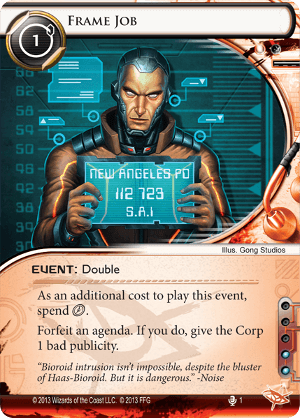
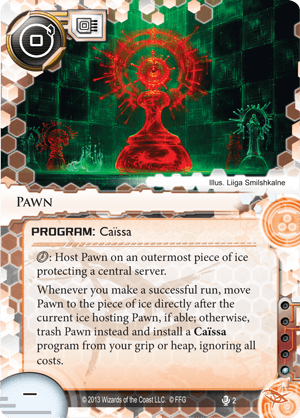
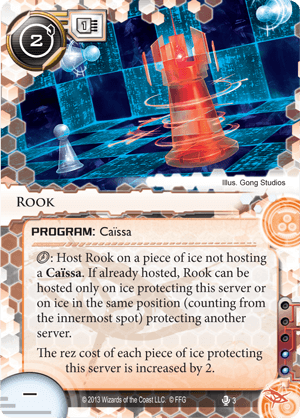
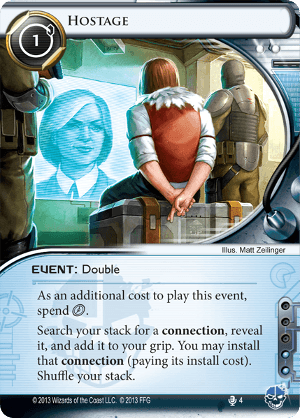


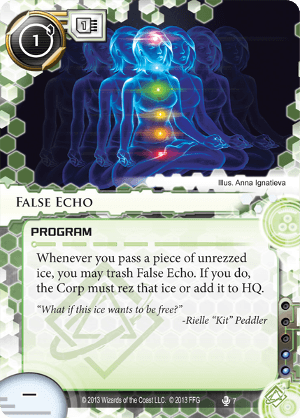
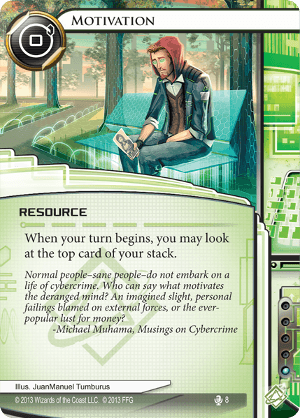
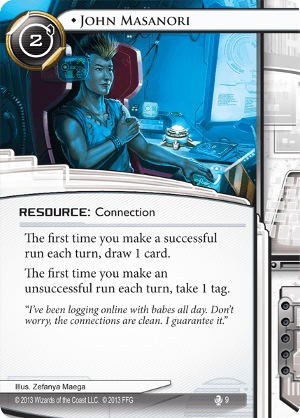
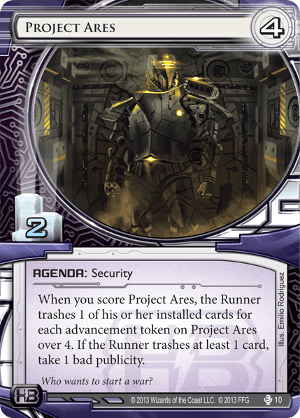
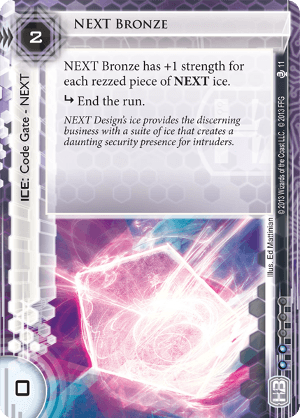

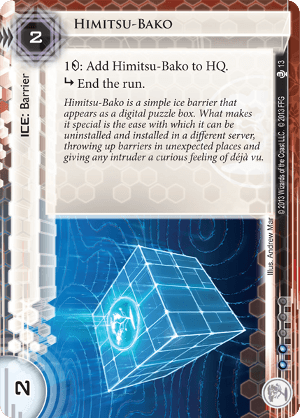

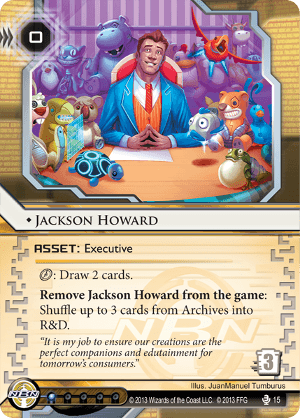
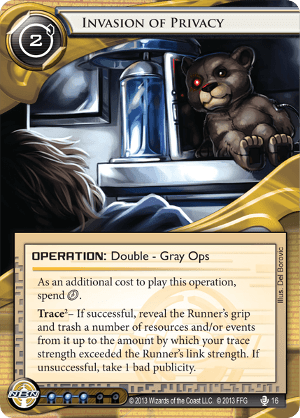
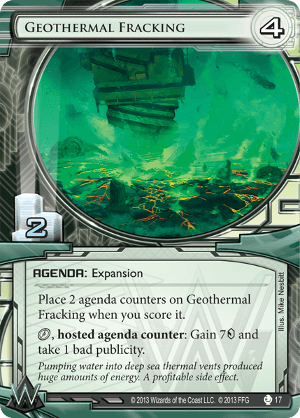
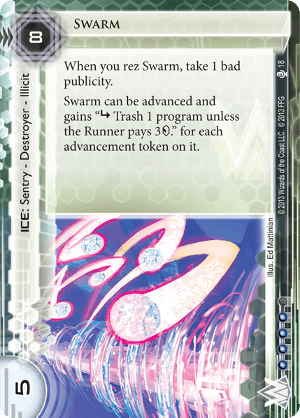
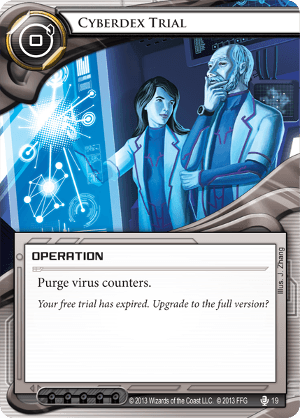
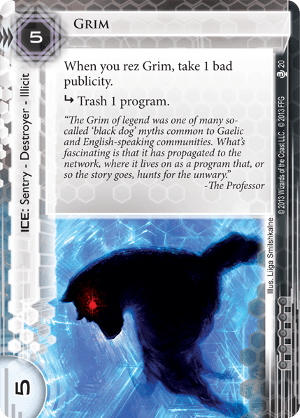
No comments:
Post a Comment